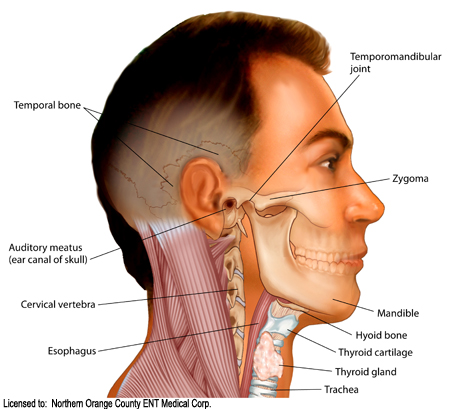Head & Neck Cancer in India
About Head & Neck Cancer ?
Head and neck cancer is cancer that starts in the lip, oral cavity (mouth), nasal cavity (inside the nose), paranasal sinuses, pharynx, and larynx.
Most head and neck cancers are biologically similar. 90% of head and neck cancers are squamous cell carcinomas, so they are called head and neck squamous cell carcinomas (HNSCC). These cancers commonly originate from the mucosal lining (epithelium) of these regions.Head and neck cancers often spread to the lymph nodes of the neck, and this is often the first (and sometimes only) sign of the disease at the time of diagnosis.
Signs and symptoms
Throat cancer usually begins with symptoms that seem harmless enough, like an enlarged lymph node on the outside of the neck, a sore throat or a hoarse sounding voice. However, in the case of throat cancer, these conditions may persist and become chronic. There may be a lump or a sore in the throat or neck that does not heal or go away.
Mass in the neck
Sinus congestion, especially with nasopharyngeal carcinoma
Bad breath
Painless ulcer or sores in the mouth that do not heal
White, red or dark patches in the mouth that will not go away
Slurring of speech (if the cancer is affecting the tongue)
Hoarse voice which persists for more than six weeks
Prognosis
Although early-stage head and neck cancers (especially laryngeal and oral cavity) have high cure rates, up to 50% of head and neck cancer patients present with advanced disease.Cure rates decrease in locally advanced cases, whose probability of cure is inversely related to tumor size and even more so to the extent of regional node involvement.
Head & Neck

Alcohol and tobacco
Alcohol and tobacco play a significant role.Alcohol and tobacco are likely synergistic in causing cancer of the head and neck.Smokeless tobacco is an etiologic agent for oral and pharyngeal cancers (oropharyngeal cancer).Cigar smoking is an important risk factor for oral cancers as well. Other potential environmental carcinogens include occupational exposures such as nickel refining, exposure to textile fibers, and woodworking.
Symptoms and side effects
Patients with head and neck cancer may experience the following symptoms and treatment side effects:
Eating problems
Pain associated with lesions
Mucositis
Nephrotoxicity and ototoxicity
Gastroesophageal reflux
Radiation-induced osteonecrosis of the jaw